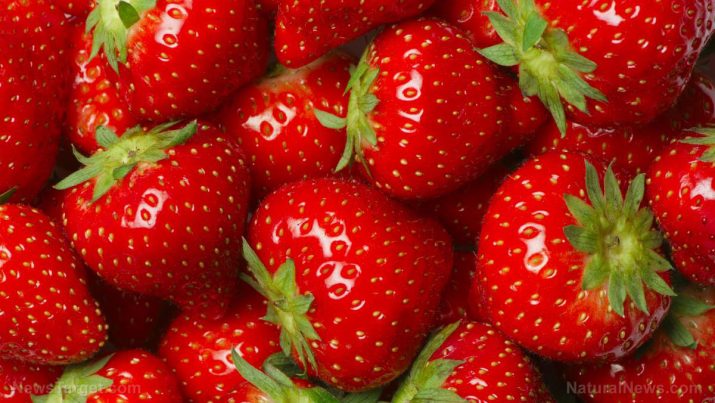
How to store and preserve strawberries for maximum freshness and flavor
Saturday, June 07, 2025 by Evangelyn Rodriguez
http://www.naturalnewstips.com/2025-06-07-how-to-store-preserve-strawberries-maximum-freshness.html

- Choose firm, vibrant red berries with fresh green caps; avoid bruised or moldy ones. Opt for organic, farm-fresh strawberries for better flavor and nutrition.
- Store unwashed berries in a single layer on a paper towel-lined container in the fridge (32-36 F). A vinegar soak or hot water rinse can reduce mold spores before refrigeration.
- Wash, hull and dry strawberries, then freeze individually on a tray before transferring to airtight containers. Frozen berries last up to 12 months.
- Slice evenly and dry at 135 F for 6-12 hours. Store in airtight containers with oxygen absorbers for up to a year.
- Simmer mashed strawberries with low-sugar pectin, pack into sterilized jars and process for shelf-stable jam lasting a year or more.
Strawberries are a beloved superfruit and culinary ingredient, but their short shelf life limits their usability. With the right techniques, however, they can be stored and preserved to maintain freshness, flavor and nutritional value for weeks or even months.
Here’s a practical guide to help you enjoy strawberries all year round. (h/t to OldWorldGardenFarms.com)
Choosing the right strawberries
The first step to successful preservation starts with selecting high-quality berries. Look for firm, plump strawberries with a vibrant red color and fresh green caps. Avoid mushy, bruised or moldy berries as well as those with bad spots as they spoil quickly and are likely unsafe to eat.
If you’re after nutrition and flavor, choose farm-fresh organic strawberries like those you can find in farmers’ markets, instead of store-bought strawberries. Farm-fresh strawberries are cleaner, fresher and more nutritious.
Short-term storage: keeping strawberries fresh for a week
To extend their shelf life for a week, store unwashed strawberries in a single layer on a paper towel-lined container with a loose lid or breathable cover. The paper towel will absorb excess moisture, which tends to accelerate fruit spoilage. Refrigerate strawberries at 32-36 F in the crisper drawer.
For extra protection, soaking strawberries in a vinegar solution (one tablespoon distilled white vinegar for every 12 cups of water) can kill surface mold spores. Rinse thoroughly with cold water afterward to remove any vinegar taste. Alternatively, you can wash your strawberries with hot water (recommended range: 120 F to 130 F) for 30 seconds. Remember to pat your strawberries dry afterward. Either method can be used before refrigeration without much impact on the freshness of strawberries.
Long-term preservation: freezing, dehydrating and canning
For extended storage, freezing is the simplest method. Wash, hull (i.e., remove the green stem and leaves) and dry the strawberries, then spread them on a baking sheet to freeze individually before transferring to airtight bags or containers. Doing this helps prevent clumping. Frozen strawberries can last up to 12 months and are perfect for making smoothies or baking.
Dehydrating strawberries creates shelf-stable snacks. To prepare, slice the strawberries evenly and dry at 135 F for six to 12 hours until leathery but not brittle. Store in airtight containers with oxygen absorbers to prevent moisture absorption. When stored in a cool, dry and dark place, dehydrated strawberries in airtight containers can last for one year.
Canning strawberries as a jam is another excellent way to make this easy-to-spoil fruit shelf-stable. Here’s how to make a low-sugar, chunky strawberry jam that can last a year or longer if stored properly: (Related: How to avoid wasting food: Smart storage, planning and preservation tips.)
- Give the strawberries (about 4 cups) a quick wash then hull them using your fingertips or a sharp knife.
- Place the strawberries in a pot and break them up a bit using a potato masher to release their juice. Add in the calcium powder, which will serve as activator for the low sugar pectin you’ll be adding later.
- Simmer the mixture for about 10 minutes at low temperature. Do not let it boil. If the mixture starts foaming, simply give it a stir.
- Mix the low sugar pectin with a small amount of sugar (1/4 cup per two teaspoons of pectin — this ratio is good for 4 cups of mashed fruit) before adding it to the cooked strawberries to prevent the jam from clumping. Add the sugar-pectin mixture while stirring continuously to distribute evenly.
- Let the jam simmer for one to two minutes to fully dissolve the sugar and activate the pectin. Take care not to overcook to avoid denaturing the pectin.
- To check if it’s cooked, trace a spatula across the bottom of the pot. The jam should part and stay that way for a few seconds before slowly filling back in.
- Remove the jam from the heat and place inside sterilized canning jars. Recommended: Use small canning jars so you can use up opened jars quickly. This recipe can fill three half-pint jam jars.
With proper selection, storage and preservation, strawberries can be enjoyed long after their peak season. Visit FoodStorage.news for more articles about food preservation.
Learn how to keep berries fresh and mold-free by watching the following video.
This video is from the Daily Videos channel on Brighteon.com.
More related stories:
Mastering food preservation: A quick guide to air-drying fruits.
Sources include:
Tagged Under: Tags: emergency food, food freedom, Food Preservation, Food storage, food supply, fruits, goodfood, green living, homesteading, off grid, preparedness, prepper, prepping, strawberries, survival, tips
RECENT ARTICLES


Embracing the wise woman way: A new perspective on breast health
By Belle Carter

Grow more with less space: Enjoy fresh produce year-round with these gardening methods

How to store and preserve strawberries for maximum freshness and flavor

Empowering women’s health: A deep dive into Dr. Tori Hudson’s “Women’s Encyclopedia of Natural Medicine”
By Belle Carter
COPYRIGHT © 2017 NATURAL NEWS TIPS


